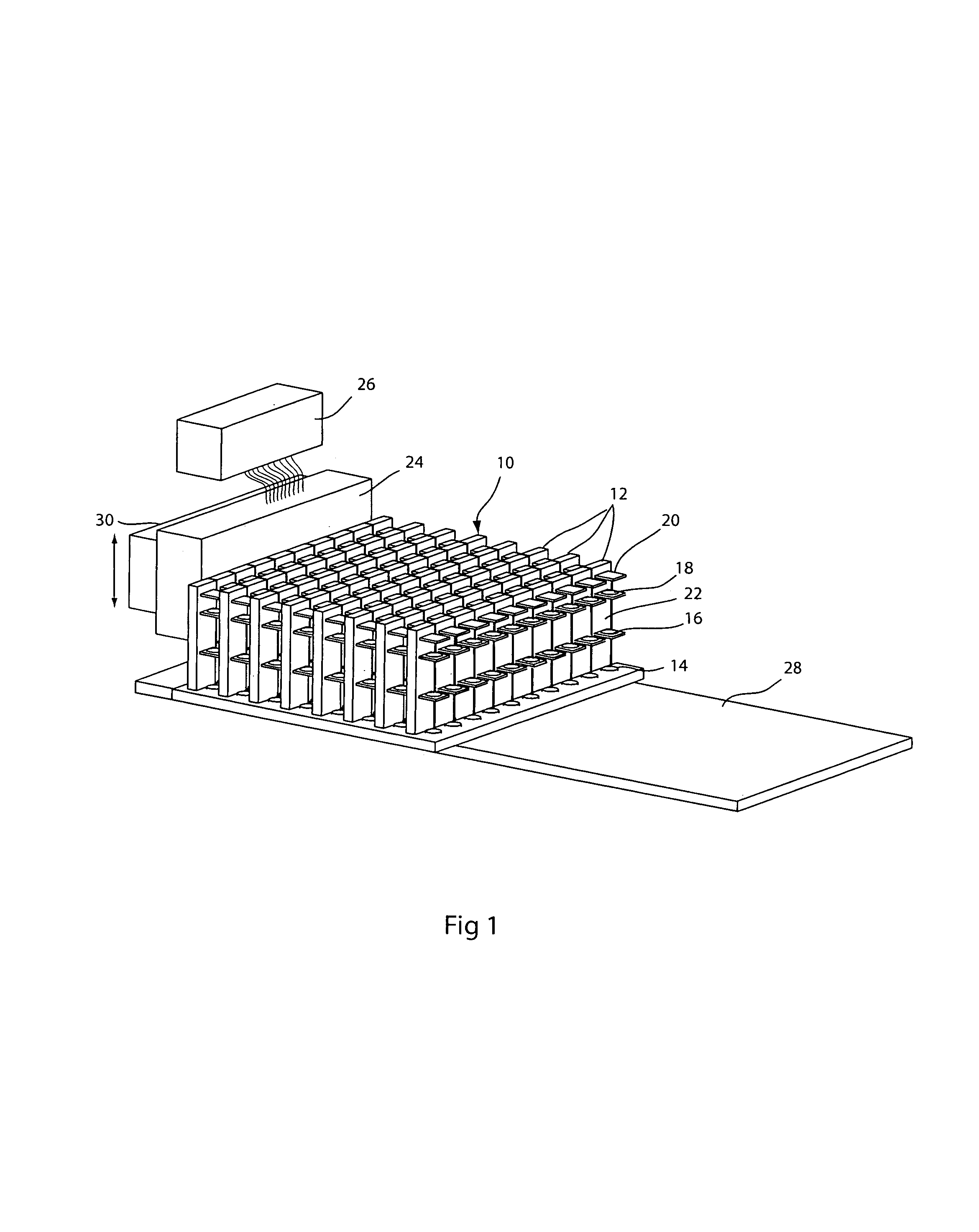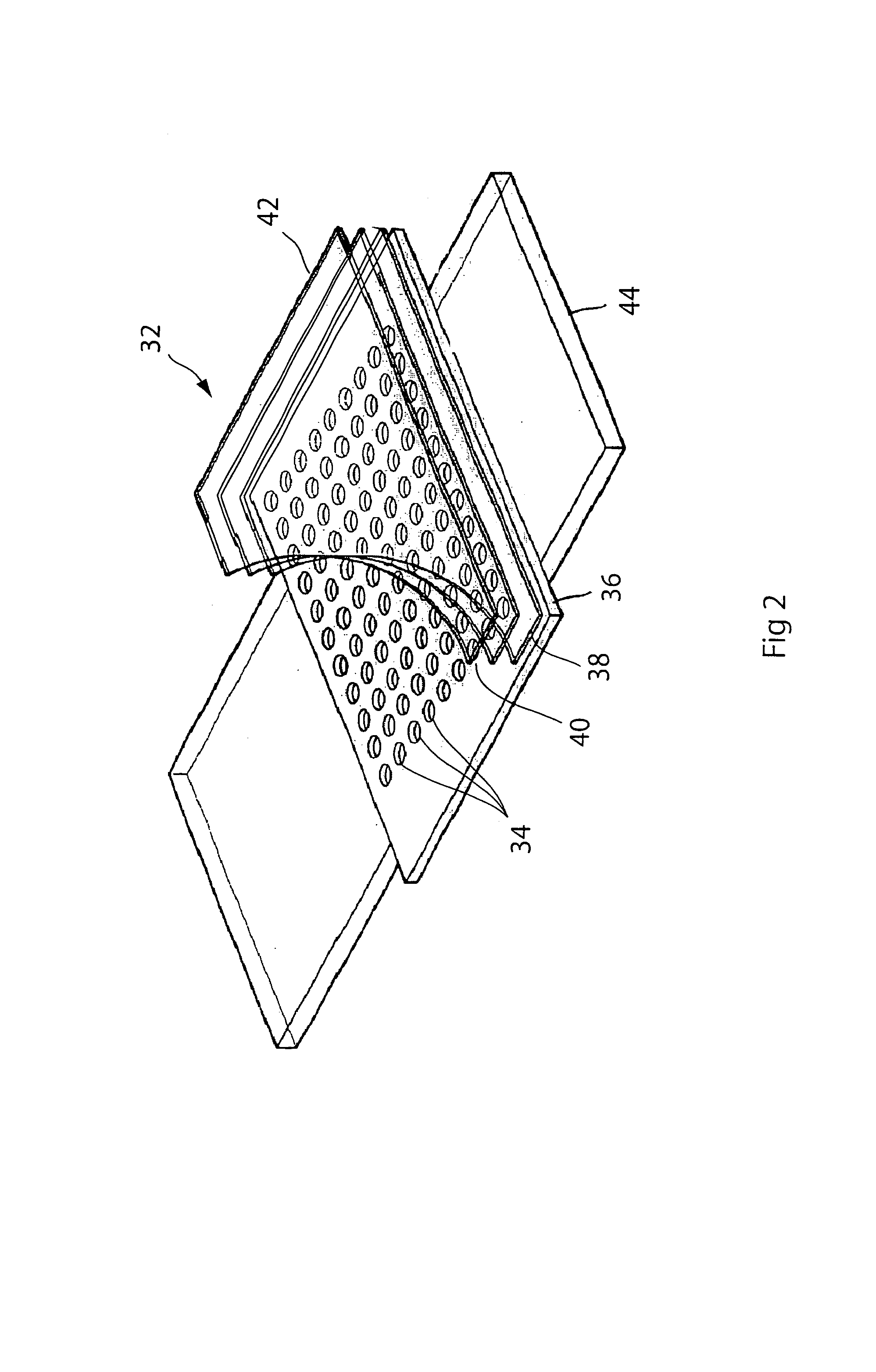EPI-illumination system for an array microscope
an array microscope and epi-illumination technology, applied in the field of microscopy, can solve the problems of ineffective use of dia-illumination, present new challenges for illumination, and prior art epi-illumination techniques cannot be used
- Summary
- Abstract
- Description
- Claims
- Application Information
AI Technical Summary
Benefits of technology
Problems solved by technology
Method used
Image
Examples
first embodiment
[0039]Turning to FIG. 5, Kohler illumination employs an optical fiber 52 whose exit port 54 is placed substantially on the optical axis of the imaging system and in the plane of the system pupil, that is, the focal plane of first lens 14, so as to emit light toward the object. FIG. 6 shows a side view of the optical fiber 52. The protective cladding 58 of the fiber is stripped back and the tip 60 of the fiber is shaped so that light propagating down the fiber is reflected laterally when it reaches the tip, forming a cone of light 62 within the back side field view of the objective 14. The fiber obscures an insignificant portion of the pupil and does not alter the imaging properties of the optical system.
[0040]FIG. 7 shows another embodiment of Kohler illumination that is particularly well suited to an array microscope of the type shown in FIG. 2. Thus, in a system having a number of optical elements 14, 16 and 18 for imaging a portion of an object 46 to a detector 42, a light guide ...
embodiment 100
[0043]The ray trace diagram of FIG. 8 illustrates a general embodiment 100 of the invention for critical illumination. In an individual microscope element as show in FIG. 3, a beam splitter 102 is placed in the optical path of the individual microscope element so as to reflect light from a source 104 toward the object plane 106. The beam splitter and source are disposed between the lens 18 and an image plane 108. The source 104 is an extended source unless the microscope is used in a confocal mode. In any case, the source is placed at a virtual image plane 110 produced by the beam splitter 102 so that the extended source is imaged into the object plane 106 so as to produce critical illumination. A point source can be substituted for the extended source if the microscope is used in a confocal mode.
[0044]A first variation 110 of critical illumination in accordance with the general embodiment 100 can be implemented as shown in FIG. 9(a) by a single beam splitter 112 that interacts with...
embodiment 200
[0047]Turning to FIG. 12, a first, refractive embodiment 200 of dark-field illumination employs a first lens plate 202 which has, for each microscope element, in addition to a first lens 204 a refractive surface 206 in the peripheral space 208 around the first lens 204. One or more light sources 210 are disposed on the back side of the first lens plate 202 and illuminate points 212 on the object plane 102. Thus, all of the light from sources 210 captured by the field of view of the refractive surface 206 illuminates the object points 212, but at an angle such that the objective 204 will only collect light which has been scattered from that object point. In general, the sources 210 are extended sources that illuminate the entire field of view of the lens 204, but point sources can be used as well.
[0048]A second embodiment of dark field illumination 250 is shown in FIG. 13. It is a variation on the first embodiment shown in FIG. 12, in that, instead of a refractive surface in the peri...
PUM
 Login to View More
Login to View More Abstract
Description
Claims
Application Information
 Login to View More
Login to View More - R&D
- Intellectual Property
- Life Sciences
- Materials
- Tech Scout
- Unparalleled Data Quality
- Higher Quality Content
- 60% Fewer Hallucinations
Browse by: Latest US Patents, China's latest patents, Technical Efficacy Thesaurus, Application Domain, Technology Topic, Popular Technical Reports.
© 2025 PatSnap. All rights reserved.Legal|Privacy policy|Modern Slavery Act Transparency Statement|Sitemap|About US| Contact US: help@patsnap.com



